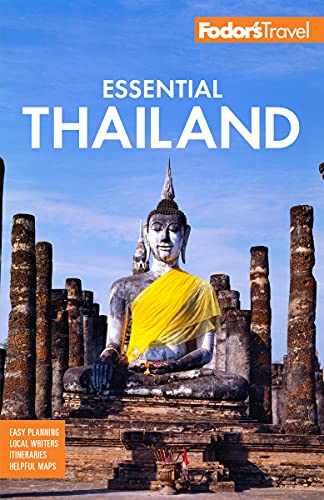Experience Thailand
Ancient Cities and Ruins
Prior to its current incarnation as a unified modern state, Thailand consisted of a series of smaller kingdoms. While some of these kingdoms were destroyed when neighboring armies invaded, others merely lost influence as they merged with other Siamese cities and remained beautifully intact.
Angkor Wat. This massive ancient Cambodian temple and its surrounding complex, built by a succession of Khmer kings between the 9th and 13th century, which has miraculously survived the ravages of time and the Khmer Rouge, is Southeast Asia's most spectacular architectural site. It's also the world's largest religious structure.
Ayutthaya. After a number of unsuccessful attempts, the Burmese sacked and brutally destroyed this city, which was the second Siamese capital, in 1767. The redbrick foundations of the Old City and its remaining stupas and wats are now beautiful ruins to explore.
Chiang Mai. The Old City of Chiang Mai has continued to develop so that today its streets include bars and minimarts. Regardless, a stroll through the back alleys, both inside and outside the old walls, reveals centuries-old masterpieces of Thai art and architecture.
Sukhothai. Thailand's first capital, Sukhothai was established in 1238 and saw more than 200 years of prosperity and artistic development known as Thailand's golden age. Sukhothai began to lose its regional influence in the 14th century, ultimately falling under Ayutthaya's control. Its Khmer- and Hindu-influenced sculpture and architecture are relatively unspoiled by the ages.
Beaches
Thailand's clear turquoise waters and soft, white, palm-fringed sands are stunning, and they offer plenty more to do than sunbathing and sunset strolls.
Koh Phi Phi. These six islands have some of the best diving and snorkeling in Thailand. Crowds flock to Maya Bay both for its spectacular scenery and because it's where the movie The Beach was filmed; Loh Samah Bay is more secluded.
Koh Samui. The beaches of Samui offer something to suit most travelers' moods: bustling Chaweng Beach, the fishermen's village of Bophut, the scented oils of spa retreats, and the briny aromas of beachfront shacks. Serious divers head for neighboring island Koh Tao.
Nang Cape/Railay Beach. These four connected beaches are only accessible by boat, but it's an easy 15-minute trip from Krabi Town on the mainland. Two of the beaches, Tonsai and East Railay, are rock-climbing centers; West Railay is known for its gorgeous sunsets; and beautiful Phra Nang has a cave with phallic offerings left for a fabled princess.
Phang Nga Bay. This national marine park is an eerily beautiful landscape dotted with limestone islands and karsts that rise like vertical sculptures from the sea. Many people come to kayak, to visit James Bond Island, or explore sea caves with prehistoric rock art.
Similan Islands. These nine islands in the Andaman Sea, part of the Mu Koh Similan National Marine Park, are considered Thailand's best dive sites. Visibility is exceptional, and encounters with whale sharks are not uncommon. The isolation heightens the appeal.
Shopping
The first time you set foot in one of Thailand's ubiquitous markets you'll be absolutely mesmerized by the variety of goods, from hand-carved figurines to polo shirts with the alligator slightly askew. In larger cities, malls sell international brands at prices significantly lower than in Singapore or Hong Kong.
Bangkok's Chinatown. In Bangkok, if you ask where you can buy something, the answer is usually, "Try Chinatown." Anything goes in this labyrinthine quarter, equally flush with gold shops and grubby souvenir stalls.
Bangkok's Shopping Streets. Bangkok's glitziest megamalls are located on a section of Thanon Rama I and Thanon Ploenchit. A skywalk links the malls, including upscale Siam Paragon, Siam Center, and Central World, allowing you to bypass the heat and congestion of the busy streets below. There's a lot more than clothing here, too—great bookshops, fabrics, electronics, Ferraris, iPads. Siam Paragon mall even has an aquarium where you can scuba dive.
Chatuchak Weekend Market. Also called "JJ," this is one of the world's largest markets. Every weekend, thousands of locals and tourists flock to northern Bangkok to navigate the mazes of stalls shopping for pets, clothing, souvenirs, and almost anything else imaginable.
Night Markets. Put on your best bargaining face and hit the streets of Silom, Patpong, Sukhumvit, and Khao San for the best night-market shopping in Bangkok. Most towns, including Chiang Mai, Pattaya, and Hua Hin, have great souvenirs available after dark.
Pantip Plaza. This is Bangkok's premier electronics mall, on New Phetchaburi Road in Ratchathewi. Anything digital, you will find here—new or used.
Trekking
Thailand's mountain forests would be good for trekking for their rugged beauty alone, but this terrain is also home to hill tribes—Karen, Hmong, Yao, and others—that maintain many of their traditional languages and cultures. The more remote the village, the more likely this is so (and the more challenging the trek). Do some research on tour operators to make an informed choice.
Chiang Mai. The city is one of two northern centers for both easygoing and adventurous tours to hill tribe villages, some of which accommodate overnight visitors. Elephant rides and bamboo rafting are often included. From here it's easy to get to departure points in Pai and Mae Hong Son.
Chiang Rai. Another northern gem for soft-adventure enthusiasts, Chiang Rai has many tour operators and individual guides. Lahu, Akha, and Lisu villages are all easily accessible from here. There's a growing number of eco-conscious initiatives, and it pays to shop around, both here and in Chiang Mai. Guesthouses can often recommend guides.
Kanchanaburi. Though Kanchanaburi itself is a touristy town, the surrounding area offers some of the most untouched landscape in the country. Parts of Sai Yok National Park, with its Kitti's Hog-nosed Bats (the world's smallest mammal), are easy to reach from Kanchanaburi, as is Erawan Waterfall.
Luang Prabang region. Treks in northern Laos transport you back in time—somewhat. These days, even some of the most remote hill country villages have cell phones, solar panels, and micro hydropower systems that generate enough power to run a TV.




